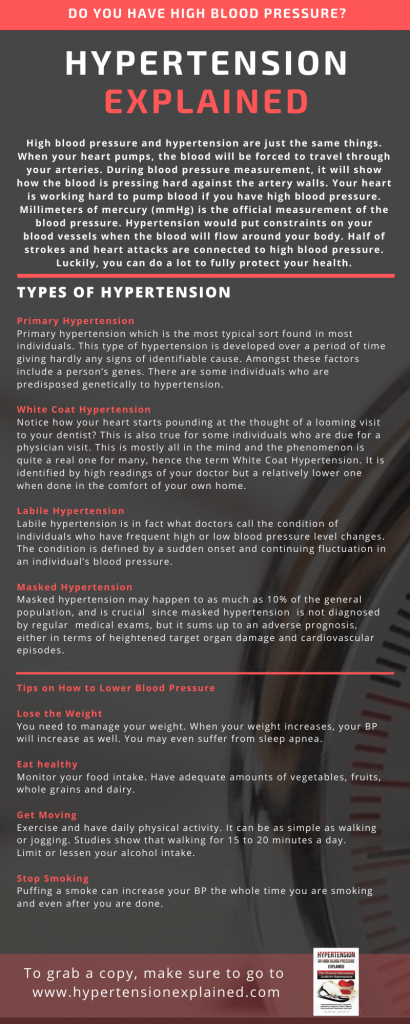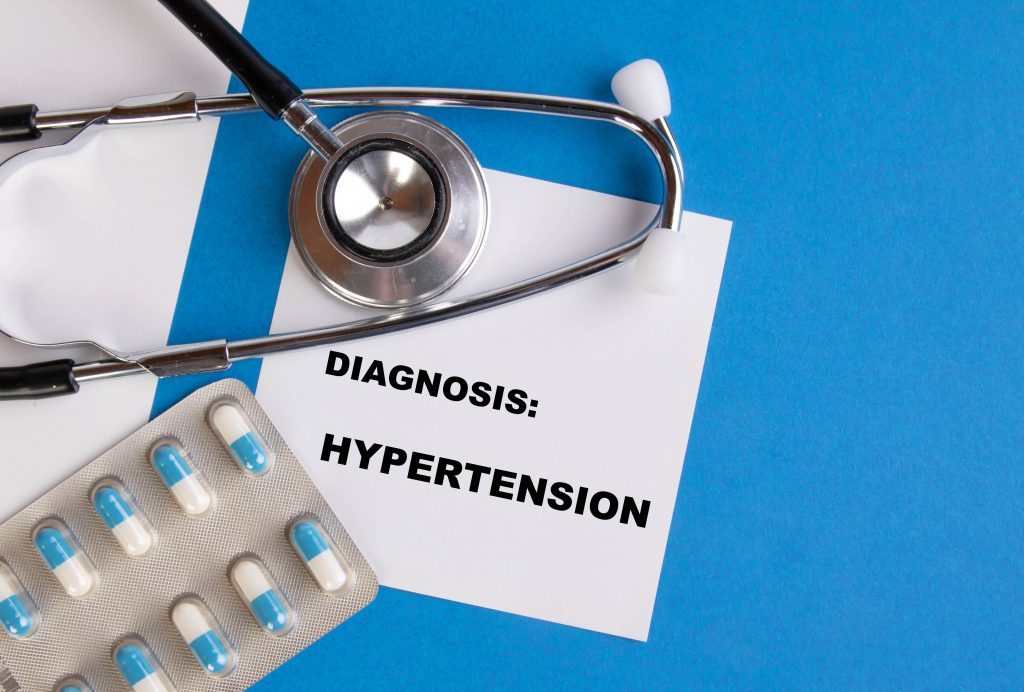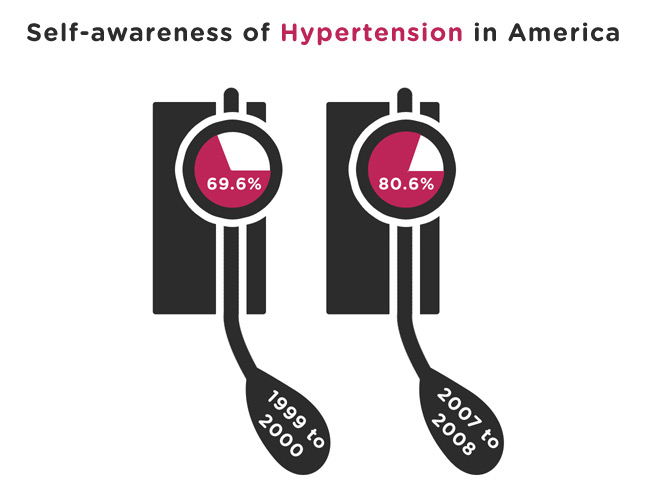What are the different kinds of hypertension? To fully understand what hypertension is, you need to look at it from the medical side. High blood pressure and hypertension are just the same things. When your heart pumps, the blood will be forced to travel through your arteries. During blood pressure measurement, it will show how the blood is pressing hard against the artery walls. What are the different kinds of hypertension? Your heart is working hard to pump blood if you have high blood pressure. Millimeters of mercury (mmHg) are the official measurement of the blood pressure. When you are viewing the blood pressure monitor, you can see the instrument going up and down.
What are the different kinds of hypertension? In most cases, there is no symptom for your hypertension. Even if your blood pressure is high, you might still feel life. You should have your blood pressured checked by a health representative to know whether or not you have hypertension. Unfortunately, this is the only way for you to do so. Some community centers or library might give blood pressure checks, especially in special events. Your hypertension has reached a high level as well as considered as an emergency if you already see symptoms appearing.
Systolic vs. Diastolic
A sphygmomanometer is the blood pressure monitor. The word is rooted from the Greek word “sphygmos” or pulse and add that to the French word “manometer” or the “pressure meater. In reading the blood pressure, it has two numbers:
- Systolic pressure: this shows the force on your arteries during a heartbeat.
- Diastolic pressure: this shows the force on your arteries between heartbeats.
Common Symptoms
Vertigo, lightheadedness, a buzzing or ringing in the ears – called tinnitus is also reported by other individual as well as a change in vision or episodes of fainting. However, these symptoms may also be associated with some sort of anxiety or a situation of duress rather than with high blood pressure itself. Knowing the causes can make quite the difference to anyone who may suspect they could be prone to the condition. Hypertension comes in two sorts and each type is caused by different things.
You may need to intake medications to get your blood pressure down, this might be said by your doctor. You need to take in the medications as given by your health professionals, so you can get the needed benefits. If you believe there are side effects, tell you doctor about it for him/her to adjust the medications.
Types of Hypertension
What are the different kinds of hypertension? Ethnicity also comes into play with regard to hypertension development. The risk of developing hypertension is equally the same for both male and females; however men have notably been more prone to hypertension even at a young age. On the other hand increase in susceptibility for women increase as a female matures.
Hypertension is not always apparent nor is it usually accompanied by visible symptoms, and is typically identified through screening. Most people with the condition are made aware of having the condition or when they seek healthcare for a physical issue unrelated to hypertension. There are a few individuals with high blood pressure that report headaches particularly describing the location of the pain at the back of the head and during the morning. Before we delve deep on each of the different types of hypertension, check out this infographic below and see if you’ve experienced such symptoms:

Primary Hypertension
What are the different kinds of hypertension? Primary hypertension which is the most typical sort found in most individuals. This type of hypertension is developed over a period of time giving hardly any signs of identifiable cause. Amongst these factors include a person’s genes. There are some individuals who are predisposed genetically to hypertension. This could happen because of genetic abnormalities or gene mutations which were passed down from parents to child.
White Coat Hypertension
What are the different kinds of hypertension? Notice how your heart starts pounding at the thought of a looming visit to your dentist? This is also true for some individuals who are due for a physician visit. A visit to the doctor, for some is an experience ridden by inherent anxiety. So there will be times when you get a high reading when your doctor does this simple procedure. This is mostly all in the mind and the phenomenon is quite a real one for many, hence the term White Coat Hypertension. It is identified by high readings of your doctor but a relatively lower one when done in the comfort of your own home.
Labile Hypertension
Labile hypertension is not to be mistaken for borderline hypertension. It is in fact what doctors call the condition of individuals who have frequent high or low blood pressure level changes. The condition is defined by a sudden onset and continuing fluctuation in an individual’s blood pressure, which typically heighten from a normal, healthy blood pressure reading to a high blood pressure reading during varied times throughout the day.
There is a divide in the medical community about labile hypertension. Some see it as a faulty concept and, hence a faulty diagnosis whilst other see it as a condition which is treatable. Either way, labile hypertension is believed generally to have less clinical impact and significance on a patient as compared to the better understood condition called “fixed” hypertension. Fixed hypertension is also a more dangerous condition. Guidelines for treatment of labile hypertension are vague and there are no accepted quantitative criteria to identify or understand the condition even though most physicians and health care providers are aware and know of the term. Nor are there guidelines for criteria of giving it as diagnosis.
Masked Hypertension
What are the different kinds of hypertension? Masked hypertension may happen to as much as 10% of the general population, and is crucial since masked hypertension is not diagnosed by regular medical exams, but it sums up to an adverse prognosis, either in terms of heightened target organ damage and cardiovascular episodes. It is identified as a normal blood pressure reading in the clinic or doctor’s office of <140/90 mmHg, but a high blood pressure out of the clinic i.e. ambulatory daytime or home blood pressure >135/85 mmHg. Some probable characteristics of patients who have masked hypertension are stress, smoking and drinking habit, male populace, increased physical activities, and young patients.
Masked hypertension has also been identified in individuals and patients treated for hypertension. It was also described to have a worse prognosis than given from the clinic pressure in children in whom which masked hypertension could be the beginning of sustained hypertension.
Managing Hypertension
You also need to have a healthy lifestyle in order to prevent or manage your hypertension, these are some of the steps that you need to take. It’s also just as important to follow a healthy lifestyle in order to manage or prevent hypertension. Try to take the following steps:
- Keep a healthy weight
- Stay active and take exercise
- Follow a healthy diet and cut down on salt
- Stop smoking
- Avoid drinking too much alcohol or caffeine
- Find ways to relax and manage stress
It is very difficult to change your lifestyle, however, changing it would give you outstanding benefits. By now, we should have already answered the question, what is hypertension. You can do some changes in your life that would fully manage your blood pressure as well as giving you more confidence, energy and great well being.
Blood Pressure Readings

The mixture of this number is typically the blood pressure result. The first thing that comes up is the systolic pressure and usually is higher than the diastolic. If you have 120 systolic and 90 diastolic, your nurse or doctor will state that your blood pressure is “120 over 90” or will be written as 120/90 mmHg.
Your health care professionals should be the one to take your blood pressures especially if you believe you have hypertension. This would have followed-up readings that you can take at home. Your health professionals would tell you how to take the readings at home. In surgery, the hypertension is set at 140/90 mmHg or even higher, while 135/85 mmHg or higher if you are doing home readings.
Non – Modifiable Risks
What are the different kinds of hypertension? You need to know the risks as well as its causes, to fully understand what is hypertension. In most cases, we do not really know this, but we know what would increase your risks. Here are some other risks that you should know about. These are non-modifiable risks:
- Age: This illness is more common when people start to age.
- Genes: Caribbean or African-bound families are more likely to have hypertension, especially because high blood pressure could run in your family.
- Other medical conditions: Other conditions that could increase your high blood pressure includes sleep apnoea, kidney problems, hormone or connective tissue conditions, or lupus.
- Pregnancy: There are varied issues that could happen during your pregnancy. You always need to contact your midwife or GP to know that everything is okay.
Medications
The following are the medications that could also raise your high blood pressure:
- The combined oral contraceptive pill
- Steroid medication
- Non-steroidal anti-inflammatory drugs (NSAIDs) such as ibuprofen and naproxen
- Over-the-counter cough and cold remedies
- Some herbal remedies particularly those containing liquorices
- Some recreational drugs such as cocaine and amphetamines
Changing Your Lifestyle
You can also ask your local pharmacist or doctor on how the following medication might affect your blood pressure. The way that you live will have a great effect on your blood pressure, however, changing your lifestyle would also reduce the risk of hypertension. If there are non-modifiable skills, there are also modifiable skills. Not exercising, eating too much salt, smoking, and being overweight are some other things that could potentially increase your blood pressure. It would also include taking recreational drugs, not getting enough sleeps for a long time, and drinking too much alcohol.
Lowering Hypertension

Masked hypertension could be suspected in patients who have historically shown high blood pressure readings from time to time but who are normotensive when given a blood pressure reading in the clinic. This is why it is practical to keep a journal of your blood pressure readings, whether at your physician’s clinic or at home.
Patients and individuals who display this should be monitored in and out of clinic. And this is when knowing how to take your own blood pressure reading accurately comes into play. Rather than dismissing these erratic readings, individuals of this sort should be encouraged to be more mindful about being vigilant of their blood pressure highs and lows. This goes for smokers and patients whose blood pressure is in the red or the pre-hypertensive range. The probable dangers of masked hypertension are extreme. However, the optimum strategy to detect this condition in the general population is yet to have better clarity.
Health Issues Linked with High Blood
Your heart is mainly affected by your hypertension. It would also include other parts of your body and your brain. Your hypertension is also linked to the following heart conditions:
- Heart attack
- Heart failure
- Stroke
- Kidney disease
- Eye damage
- Painful legs (peripheral artery disease)
- Vascular dementia
You can lower your blood pressure; this is a great news for many people. In doing this, you can also lower the risks in having the aforementioned health problems.
Conclusion
How can we tell if we are susceptible to this illness or, worse, already suffer from it? With so much uncertainty around us, it should help to know that there are some things over which we have some control. Yes, it’s true that is not always something consistently present in our lives, but there are some areas where we can work on to be able to live better, healthier lives. There are a number of factors which put individuals at risk for developing high blood pressure. Aside from leading an unhealthy lifestyle, age comes into factor for tendency of developing primary or essential for people over 60 years old. Blood pressure can increase incrementally because of the arteries stiffening up and narrowing down due to the buildup of plaque. Learn more about thedifferent kinds of hypertension by watching the video below:


 I love to write medical education books. My books are written for everyone in an easy to read and understandable style.
I love to write medical education books. My books are written for everyone in an easy to read and understandable style.